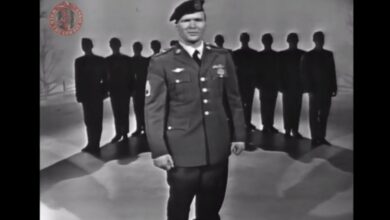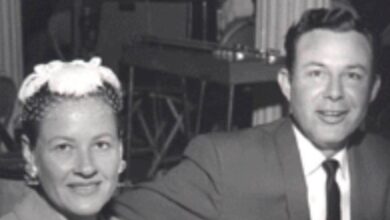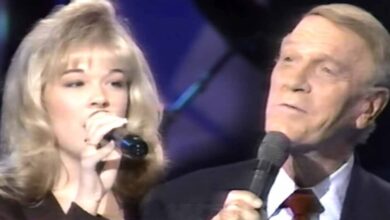The Performance Inspires A Sense Of Pride And Gratitude Among Listeners As They Honor American Veterans
Sgt. Barry Sadler’s “Ballad of the Green Berets,” released in 1966, remains a powerful emblem of military honor and sacrifice, particularly linked to the elite forces of the U.S. Army during the challenging period of the Vietnam War. The song emerged against a backdrop of societal upheaval, where public sentiment about the war grew divided, creating a poignant contrast between the pride of military service and the emerging anti-war attitudes. Sadler’s personal journey as a Green Beret provided a unique perspective, allowing him to convey his experiences and emotions through the lyrics of this iconic ballad, deeply resonating with both soldiers and civilians alike.
Born in Carlsbad, New Mexico, Barry Sadler faced significant hardships in his early life. His upbringing was marred by the emotional complexities that came with his parents’ divorce, and he grappled with the absence of his father, who passed away when Barry was still a child. These early experiences instilled in him a sense of resilience and a longing for brotherhood, qualities that would later manifest during his military service. In 1958, Sadler enlisted in the U.S. Air Force, eventually transferring to the Army, where he realized his calling and earned the esteemed title of Green Beret, a role that would define much of his adult life.
Sadler’s service in Vietnam plunged him into the intense realities of combat. It was during one of these harrowing experiences that he was gravely injured by a booby trap, leading to a long and painful recovery. It was during this time of reflection and healing that he composed “The Ballad of the Green Berets.” The lyrics serve not just as a tribute to the valor and courage of the Green Berets but also as a testament to the bonds formed in the crucible of war. The song captures the ethos of military life—loyalty, sacrifice, and honor—and it did so through the lens of someone who had lived those values firsthand.
The release of “The Ballad of the Green Berets” coincided with critical societal tensions surrounding the Vietnam War, where many Americans were grappling with their perception of the military and the nature of the conflict. As opposition to the war grew, Sadler’s ballad stood as a proud declaration of faith in the soldier’s mission. Its stirring melody and heartfelt message became a voice for those who stood firm in support of the troops, simultaneously capturing the essence of what it meant to serve. The song quickly rose in popularity, ascending to the top of the Billboard Hot 100 where it remained for five consecutive weeks. Its success not only marked a significant moment in popular music but also reflected the complex relationship that the American public had with its military.
Though Sadler achieved notable success with his ballad, he found difficulty in replicating that triumph in his subsequent endeavors. After his brief career as a singer, he turned his focus to writing and acting, producing a series of novels and exploring various artistic paths. Among his literary contributions was the pulp fiction series, “Casca,” which revolved around the life of a Roman soldier cursed to wander through time. Despite these efforts, the overwhelming recognition of “The Ballad of the Green Berets” often overshadowed his later works, continually tying back his legacy to that one powerful song.
As he navigated through post-military life, Sadler faced myriad personal challenges. His later years were marred by legal troubles and a significant injury he sustained during a shooting in Guatemala. This incident not only impacted his health but also complicated his already tumultuous personal life, juxtaposing the earlier glory associated with his military service and musical success. Throughout these struggles, however, Sadler maintained a connection to the themes of duty and honor that had characterized his earlier life, continuing to reflect on the sacrifices of service members.
In 1989, Barry Sadler’s life came to an untimely end, yet he left behind an impactful legacy that remains relevant in American culture today. “The Ballad of the Green Berets” is frequently performed at military events and remembrance ceremonies, serving as a heartfelt homage to those who have served and sacrificed for their country. The song encapsulates not only the valor embodied by the Green Berets but also resonates with all service members, commemorating their unwavering dedication amid the trials of warfare.
The enduring significance of Sadler’s anthem reflects the complex relationship between military service and public perception. As generations grapple with the legacy of conflicts, “The Ballad of the Green Berets” continues to provide a narrative of pride and sacrifice, transcending political divides. For many, it stands as a reminder of the personal costs of war, the bravery associated with military life, and the importance of honoring those who serve despite the controversies that may surround their missions.
Over the years, the song has been covered and adapted by various artists, demonstrating its timeless appeal. Each new rendition introduces the ballad’s powerful message to fresh audiences, ensuring that Sadler’s legacy continues to inspire feelings of respect and admiration for military service. The influence of “The Ballad of the Green Berets” can be seen across multiple platforms, from film and television to public commemorations, bridging the gap between history and contemporary discourse regarding military honor and sacrifice.
Ultimately, Barry Sadler’s “Ballad of the Green Berets” stands not just as a song but as a cultural touchstone, encapsulating the complexities of military identity and experience. It fosters a sense of connection between the military and the broader American public, promoting understanding and respect for those who serve. The themes of loyalty, sacrifice, and courage embedded within the song continue to resonate, forming a poignant reminder of the sacrifices made by countless individuals in uniform throughout history, as well as the unwavering spirit of service that persists in the hearts of those who follow their call to serve.
&ab_channel=WhenTheCowboySings





